| My
memories of the Essoldo,
Bethnal Green Road
might have continued in
this vein were it not for
repercussions that
resulted from the shivers
of desperation that
rippled through Hollywood
in the early 1950s. Television
had arrived, and as the
decade progressed, more
and more sets were being
sold around the world
much to the horror of movie
moguls. The advent
and progression of
television meant more and
more people chose to stay
home and obtain their
entertainment for free,
if you exclude the cost
of a license required in
many countries including
the United Kingdom. And
this meant that fewer and
fewer people were now
prepared to leave the
warmth and safety of
their homes and venture
out and pay for the
privilege of sitting
in a darkened room with a
host of strangers and
watch moving and talking
images shown on a wall.
Television sent shivers
up the spine of both
Hollywood and British
film studios. Once ticket
sales fell, so did
profits causing many in
the film industry to
suffer sleepless nights
as well as nervous
breakdowns and a few
heart attacks. 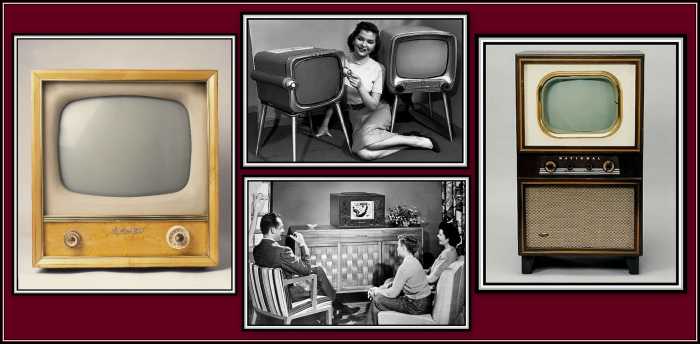
Movie
moguls being first and
foremost businessmen knew
well that desperate times
did indeed call for
desperate measures. To
avert the decline in
cinema attendance and
also hopefully lure the
public back to the
cinema, the moguls knew
that they had to come up
with something spectacular.
To get customers to
part with their hard
earned cash, they needed
to have something that television
could not, as yet,
offer. They not only
needed spectacle, they
needed something with flash.
They needed something
to make the public sit
up and take notice.
The moguls knew
that audiences would pay
to be teased and tantalised,
as well as to be thrilled
and frightened.
The moguls
chose the thrill and
frighten route and
began to produce films
where photographic images
appeared to stand out
both with and without the
use of special
glasses. In this way,
audiences became a
participant in the action
on the screen. Soon
customers were being
thrilled and squealing
with wonder and delight
as they dodged flaming
arrows, lances and other
objects seemingly being
hurled at them from the
screen. They were both
frightened and
exhilarated by marauding
circus animals that
seemed to jump off the
screen at them. Soon
audiences were screaming
in terror as phantoms and
gorillas appeared to
reach out to grab them
from the safety of their
cinema seats. Although
being of a young age, I
was nonetheless an avid
cinema-goer with what I
thought was good taste.
Despite thinking of
myself as a sophisticated
patron and connoisseur
of film, I soon
embraced spectacle wholeheartedly
and became a devotee of
films produced in 3-D and
for the widescreen.
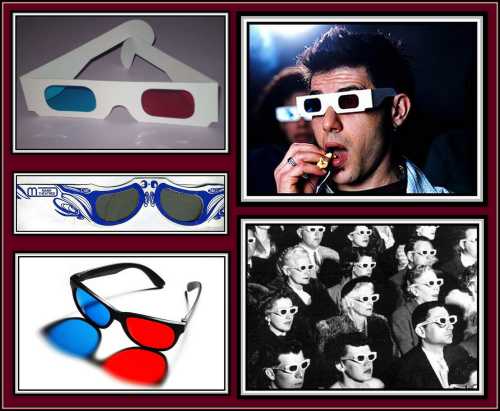
Most films
made in 3-D were
not especially good. The
major Hollywood studios
did not fully embrace the
process and produced only
a few films requiring the
need of special
glasses. Here,
through the wearing of
these glasses, the
two images projected onto
the screen were seen as
one and seen as if they stood
out! I remember
enjoying the flaming
arrows being fired
into the auditorium when
I saw Hondo. I
also remember trying to
catch both a tankard and
a banana from Howard
Keel, as he nonchalantly
flew them my way in the
film of Kiss Me Kate!
I was extremely annoyed
as a child as I was denied
access to the one 3-D
film that I really
wanted to see, House
of Wax.
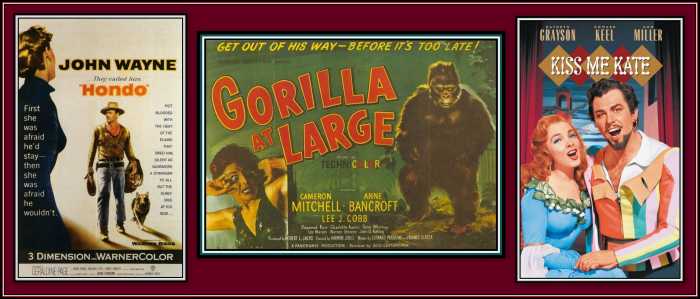
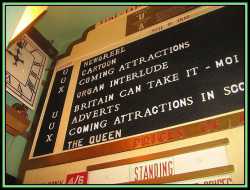 In
the 1950s, Great Britain
had a censor board in
place that gave certificates
to each film that
clearly stated who should
be allowed to view it.
Most children wanted to
see any and all films
given an X-certificate.
One had to be 16-years
old to have that right.
All kids tried to dupe
box office servers in
those times and pretend
to be of age so as to see
some of the more
titillating offerings of
the time. Sometimes you
were successful, other
times not. I remember
that on each occasion I
gained entry to an X-rated
film, I was always
sorely disappointed by
what I saw! In
the 1950s, Great Britain
had a censor board in
place that gave certificates
to each film that
clearly stated who should
be allowed to view it.
Most children wanted to
see any and all films
given an X-certificate.
One had to be 16-years
old to have that right.
All kids tried to dupe
box office servers in
those times and pretend
to be of age so as to see
some of the more
titillating offerings of
the time. Sometimes you
were successful, other
times not. I remember
that on each occasion I
gained entry to an X-rated
film, I was always
sorely disappointed by
what I saw!
I can only
remember one film being
awarded an H-certificate.
Essentially, this rating
was the same as an X-certificate
since it meant that no
one below the age of
16-years would be allowed
to see it in a cinema.
However, the H-certificate
added a tantalising
quality to the film, one
that implied this was a horror
film with special
qualities guaranteed to
chill the blood. This is
just the kind of film
that every kid wanted to
see! Cinemas had to be
strict when it came to
allowing entry to
questionable 16-year olds
since the management
received a hefty fine
should a youth be
found present during the
screening of such a film.
Naturally, I was too
young to be passed by the
cruel and inquisitive eye
of the box office agent
and so was denied access.
Mind you, I think that I
was about 10-years old
when this film was first
released and could expect
nothing else but denial.
This film, House of
Wax, was one of
Vincent Price’s first
horror films and was a
great financial success.
The advertisement for
this film was both
frightening and
tantalising as it showed
the central character
wrapped in a long black
cloak and with a very
wide brimmed hat pulled
down over his face. Other
images showed a woman in
mid-scream and of an
inferno promised in the
film. Truly great stuff!
I regret never having
seen this film in the
wonders of 3-Dimension and
again I feel that my
childhood was deprived as
a result!
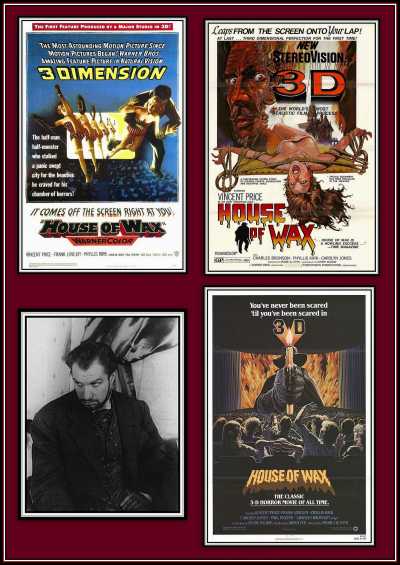
I did
eventually see House
of Wax, but this was
years later and on television
and in black and
white! I remember
seeing it on a Saturday
afternoon in the winter
of 1969 while living in
Toronto. One of the local
television channels was
showing the film and I
had stayed at home
purposely to watch it. I
remember looking forward
to seeing it and so
prepared myself for a
great and a grand
experience. I had taken
my telephone off the hook
so as not to be disturbed
and had surrounded myself
with an assortment of
sweetmeats and other
special treats. After
all, this was going to be
an important film and
one that I had been
looking forward to seeing
for some years by then.
The film started and it
soon became obvious,
although I did not fully
appreciate this at the
time, that the film had
been hacked and chopped
to fit into the
allotted time and that
much of the story had
been sacrificed in so
doing. The film ran for
ninety minutes with
endless commercial
breaks.
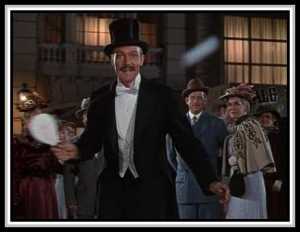 The
film proved to be dull to
say the least and was a
great disappointment.
There were scenes that
had I had the opportunity
to see in 3-Dimension and
in colour then my opinion
of the film would perhaps
have been less negative.
For example, the scene
where a barker standing
and hawking in front of
the House of Wax
and hitting a ball
attached to a bat back
and forth had a spark to
it. When seen in 3-D, the
ball would appear to leap
off the screen seemingly
aimed directly at the
audience. This no doubt
brought yelps and cries
from the customers, as
they ducked to
miss the non-existent
ball flying towards them.
Sadly what should have
been a spectacular finish
to the film was dull and
completely lacking in
excitement in the hacked
television version.
During the final scene,
the House of Wax burns
to the ground and the
owner means a suitable
and horrific end. There
was a battle between
villain and hero amidst a
number burning beams,
which periodically
crashed to the ground.
While the hero attempted
to save the damsel in
distress, the wax
figures were melting.
Naturally the camera
lingered on the faces
which, as the wax melted,
became horribly
disfigured and produced a
horrific site. Once the
wax had dipped away, it
became clear that the
villain had made his
figures from the corpses
of his victims. Without
colour, without 3-D
and without the ambiance
of a cinema audience, the
finale was dull and
uninteresting. I was very
disappointed and wished
that I had not bothered
to watch. The
film proved to be dull to
say the least and was a
great disappointment.
There were scenes that
had I had the opportunity
to see in 3-Dimension and
in colour then my opinion
of the film would perhaps
have been less negative.
For example, the scene
where a barker standing
and hawking in front of
the House of Wax
and hitting a ball
attached to a bat back
and forth had a spark to
it. When seen in 3-D, the
ball would appear to leap
off the screen seemingly
aimed directly at the
audience. This no doubt
brought yelps and cries
from the customers, as
they ducked to
miss the non-existent
ball flying towards them.
Sadly what should have
been a spectacular finish
to the film was dull and
completely lacking in
excitement in the hacked
television version.
During the final scene,
the House of Wax burns
to the ground and the
owner means a suitable
and horrific end. There
was a battle between
villain and hero amidst a
number burning beams,
which periodically
crashed to the ground.
While the hero attempted
to save the damsel in
distress, the wax
figures were melting.
Naturally the camera
lingered on the faces
which, as the wax melted,
became horribly
disfigured and produced a
horrific site. Once the
wax had dipped away, it
became clear that the
villain had made his
figures from the corpses
of his victims. Without
colour, without 3-D
and without the ambiance
of a cinema audience, the
finale was dull and
uninteresting. I was very
disappointed and wished
that I had not bothered
to watch.
Several
years later, I tried to
watch a more complete
version of the film, also
on television, but this
time in colour. Alas, the
film held no mystery for
me and I soon lost
interest and turned to
another channel. I
don’t think that I
shall ever forgive the British
Board of Film Censors for
denying me the thrill and
fear of seeing this film
in a cinema, as I would
have relished the special
effects fully!
As amusing
as 3-D was to kids
like me, paying patrons
soon became annoyed at
having to wear special
glasses and were also
annoyed at having to pay
for them in addition to
the price of a ticket. I
remember my mother being
miffed at the Empire
Leicester Square when
after paying three
shillings & sixpence per
seat to see Kiss Me
Kate, which was a
huge sum for a cinema
ticket in the early
1950s, she was then asked
to fork-out a
further one shilling
& sixpence for a
pair of these special
spectacles. I
remember being especially
pleased to get my spectacles
since many of the
comics of the day were
featuring stories in 3-D
and they were of
better quality than the
cheap one red eye-one
green eye viewer that
accompanied the comic and
needed to be held in
place. The cinema’s special
glasses were
classier and provided
dotted lines on either
side of the green-tinted
lenses, which when
folded, produced ear
pieces. The wearing
of the spectacles
avoided the
necessity of holding them
in place. In this way,
the patron had free hands
and so could unwrap
sweets, hold an orange
drink and/or eat an ice
cream without
interference to their
film experience while
also being able to
avoid any perceived
object thrown there
way from the film!
However, not every
patron appreciated the
thoughtfulness of the
management and I was most
amused to find that after
going into the
auditorium, many members
of the audience were
viewing the action
through non-folded spectacles
held up over the
bridge of their noses!
Naturally, with arms now
extended, they were
either constantly interlocking
with other
patrons or tapping
them on the sides of
their heads as they bobbed
and weaved out of the
path of a flaming
arrow!
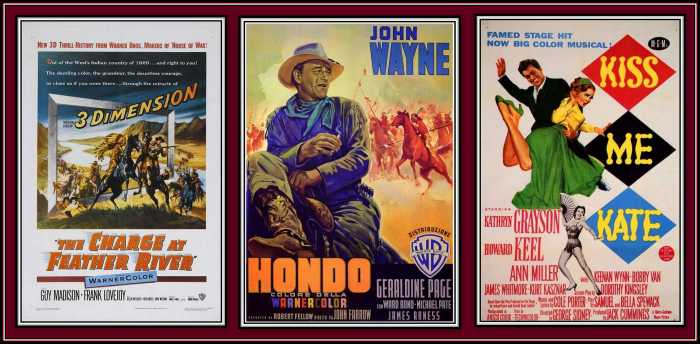
The
concept of depth had
apparently intrigued the
film moguls for
some time, but they soon
realised that people
would not tolerate the holding
or the wearing of
special spectacles for
too long and that the
novelty of objects
being flung their way
had a limited appeal. The
quest was soon on for
these features to appear
in a film but without the
use of special
glasses. Apparently,
a French scientist had
produced a lens that
would allow an image to
appear on a wider screen
than was currently in use
and would also allow
objects to appear to stand
out, thus giving the
scene depth.
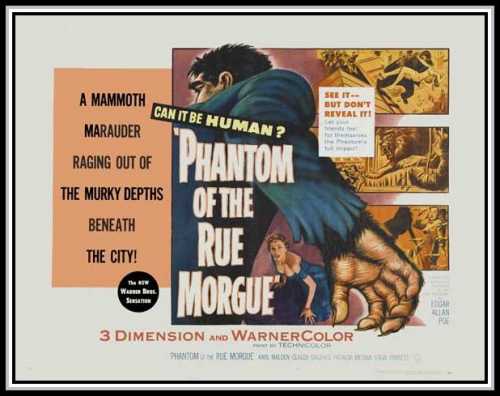
|